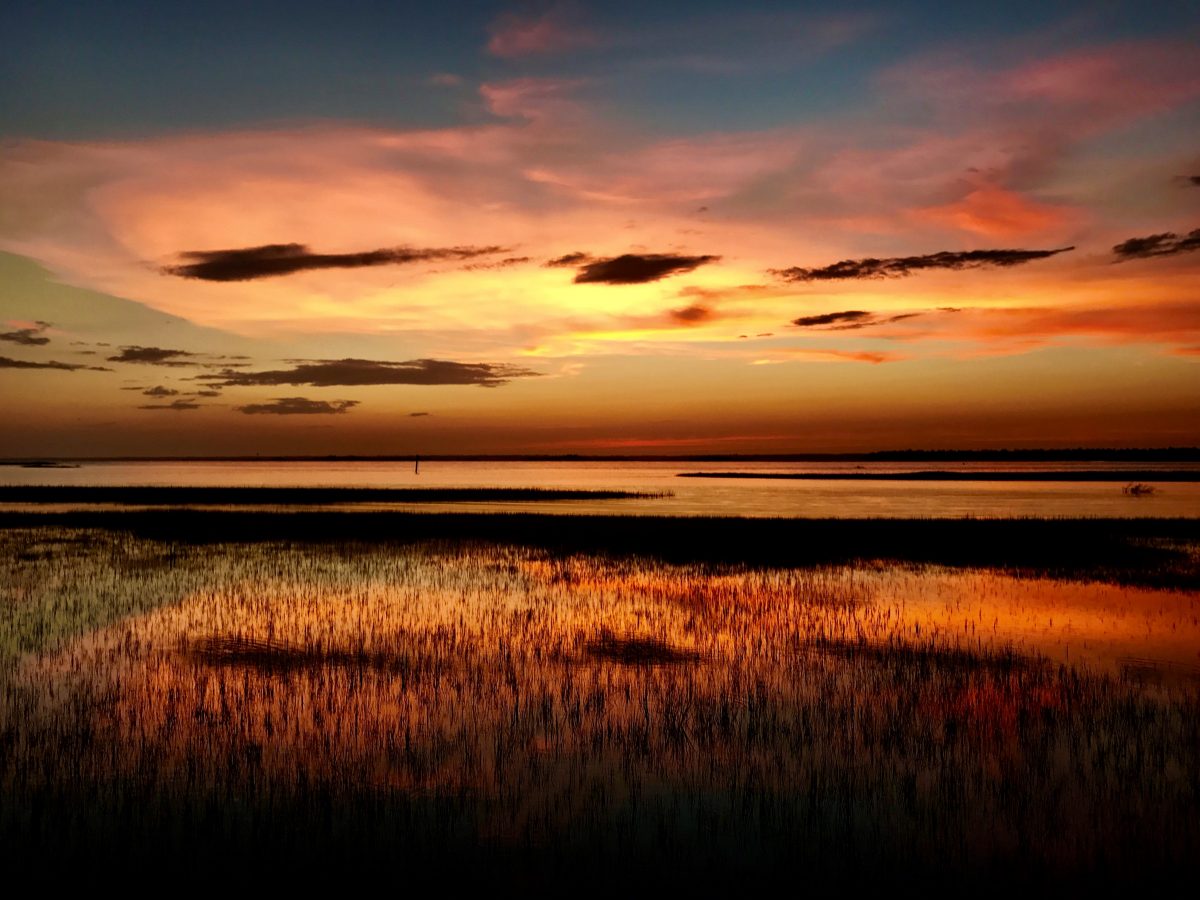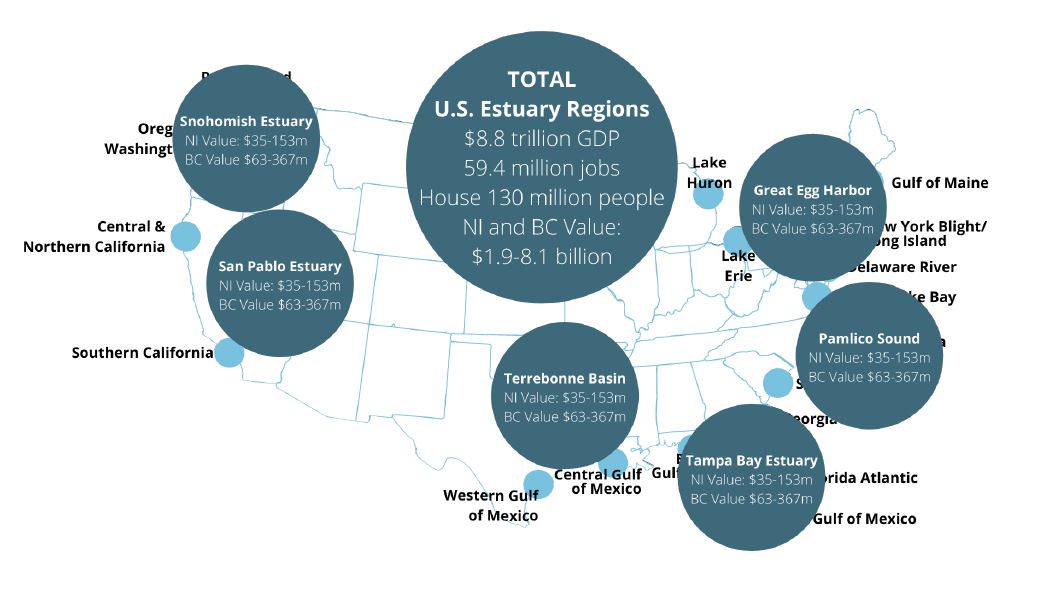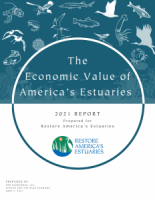
Though “geographically small,” estuaries are “economically huge,” according to a recently released update to a decade-old report on the economic value of these coastal regions where rivers mix with salt water.
Restore America’s Estuaries and The Ocean Foundation released in 2009 the report, “The Economic and Market Value of America’s Coasts and Estuaries: What’s at Stake?” Backed by the National Oceanic and Atmospheric Administration, this first report examined economic impacts of estuaries during that time to gross state and domestic product in 21 regions of the continental United States. It also reviewed the benefits of five major sectors of the economy: fisheries, energy infrastructure, marine transportation, real estate and recreation.
The 2021 update presented Nov. 3, prepared by TBD Economics and the Center for the Blue Economy, expands on the previous report and looks at natural infrastructure such as wetlands and oyster reefs, and coastal blue carbon, or the carbon captured by marine organisms and stored in coastal ecosystems, in the local economies of six case study sites: Pamlico Sound in North Carolina, Great Egg Harbor in New Jersey, Florida’s Tampa Bay, Terrebonne-Haute Basin in Louisiana, San Pablo Bay in California, and Snohomish Estuary in Washington.
“Estuaries are small places with huge economic impact. They’re 4% of the continental landmass in the U.S., eight of our 10 largest cities are along estuaries, 40% of our U.S. population and 47% of our gross domestic product are all generated from estuary counties. So what happens in estuaries affects all of us,” Restore America’s Estuaries President and CEO Daniel Hayden explained during the Nov. 3 press conference to present the report update.
Hayden said that since the first report, 15% more Americans live in coastal communities, especially within the Gulf Coast region. This means there’s more people and more property at risk than ever before. Also, there are two times the number of billion-dollar-plus storms as there were just a decade ago, resulting in 69% more deaths.

“These are trends that we’re seeing across the entire country,” Hayden said, citing a study from The Pew Research Center that found 63% of Americans say they’re seeing the effects of climate change today. “So this is no longer a future problem. It’s today’s reality.”
These storms and extreme weather are not affecting all communities equally. “There’s an increasing body of research that shows that economically disadvantaged communities are impacted much worse by coastal flooding and storms than other communities,” Hayden said. He added these storms take an immense human toll and cause disruption to families and communities, which makes it even harder for communities that are already struggling.
Hayden said there is a clear case for investment in the coast. For every $1 invested in mitigation, $6 is saved in recovery and this investment can help avoid human suffering and improve habitats. Every $1 million invested in habitat restoration creates an average of 17 jobs. “This is a much higher rate of return than the traditional industries such as coal, gas or nuclear energy generation, there’s a lot of opportunities for us to continue to invest in our coasts while investing in our economy.”
The update includes two new categories, “coastal blue carbon” and “natural infrastructure,” in its assessment of conditions in the continental U.S. This new information was included to fill considerable gaps in understanding the benefits provided by coastal natural infrastructure and blue carbon, according to the update. The values for natural infrastructure flood resilience and carbon sequestration presented in the case studies illustrate the current economic benefits provided by these two services in regions across the country.
The report explains that conserving and restoring estuaries rich in coastal blue carbon –greenhouse gas carbon dioxide sequestered in the soil — mitigates the effects of climate change and provides additional benefits such as nursery habitat for fish and reduction of storm surge impact. NOAA defines natural infrastructure as healthy ecosystems including forests, wetlands, floodplains, dune systems and reefs, that offer many benefits like storm protection through wave attenuation or flood storage capacity and enhanced water services and security.
Hayden added that the value of blue carbon sequestration totals $600 million to $3.7 billion at the six sites studied, and natural infrastructure helped avoid between $1 billion and $3.1 billion in property losses. “So we can sort of imagine the impact they have on our country as a whole,” he said.

“We also know the value of this natural infrastructure,” he said. There’s been a lot of studies that show that property behind wetlands have less storm damage, but the value depends on keeping existing wetlands intact, and thereby preventing or reducing economic losses.
Hayden said it’s critical to sustain and increase federal and state investments in our coasts.
“It’s estimated the voluntary carbon markets would grow to about $50 billion by 2030 and this provides an opportunity to fund investments in our coasts, particularly in blue carbon, as an incremental finance tool, and a chance for the attribution of blue carbon value to the wetlands increases their value,” he said. “There’s a lot of opportunity here to develop collaborations between federal, state and local governments as well as the private sector to continue investment in our estuaries.”
NOAA Office of Habitat Conservation Director Carrie Selberg Robinson explained during the Nov. 3 presentation that her office and Restore America’s Estuaries had worked about two years on the update.
“Estuaries play a really important role in protecting communities from the impacts of flooding, climate change and sea level rise. And habitats like salt marshes and seagrass beds serve as natural infrastructure that protect coastal communities from flooding and erosion,” she said.
When RAE proposed the update, Robinson said her office “wholeheartedly agreed that a more current look at the economic value of estuaries would be an important tool for all of us at NOAA and for all of our partners in conservation to better understanding of what these valuable systems are worth is a really critical tool for preserving and restoring the coastal habitats in these places that are important to our communities.”
TBD Economics President Tracy Rouleau said that the first report was a primer on the value of ecosystem services. The original report addressed the best known, at least at the time, ecosystem services, that make up the ocean, or marine, economy: tourism and recreation, commercial fisheries, ports and shipping, and energy infrastructure.
The authors included a “more contemporary view of ecosystem services” in the update with the six case studies that “connect estuaries directly to the climate crisis facing our nation in the world.”

The update estimates the value over the next 30 years of certain wetlands helping reduce flood damage and storing carbon in the soils that could offset carbon releases from other sources.
Rouleau said that the case study works under the assumption that the coastal blue carbon and the natural infrastructure values are present today and those benefits are continued over 30 years. “But if the wetlands are developed, the values are lost,” she said.
“Beyond these measurable benefits, estuaries are at the heart of so many of our coastal communities. Without healthy estuaries, ways of life that have defined our communities for generations would disappear. The value of restoring and strengthening our estuaries can, in the end, really only be measured by the value each of us place on the quality of life we pass on to our future generations,” Hayden wrote in a release about the report.
Snapshot of Pamlico Sound findings
Pamlico Sound makes up the southern part of the Albemarle-Pamlico system, which spans more than 3,000 square miles of water, and is separated from the Atlantic Ocean by the Outer Banks.
The sound’s wetlands, oyster reefs and subaquatic vegetation are features that improve water quality by reducing erosion and wave activity and filtering water. Seagrass meadows are considered some of the most important natural carbon sinks in marine environments, according to the 2021 update.

Though Pamlico Sound is a largely undeveloped estuary, with a small amount of low- and medium-intensity development, many worry that nutrient runoff from stormwater, agriculture, wastewater treatment and industrial facilities will contribute to a long-term, coast-wide problem worsened by prolonged flooding and saltwater intrusion. The report also finds concerns that wastewater, stormwater and transportation systems will be affected by saltwater intrusion, more severe and prolonged flooding and storm surge.
In 2016, recreational fisheries had a $1 billion impact on the state economy, commercial fisheries had a $180 million impact, and saltwater fishing created almost 17,000 jobs. In 2019, commercial fishers landed more than 10 million pounds of seafood valued at more than $15 million in and around Pamlico Sound. The economic impact of tourism in 2012 by Dare, Carteret, Currituck and Hyde counties exceeded $1.37 billion.
The estimated benefits from natural infrastructure in Pamlico Sound range from $48.8 million to $109.9 million over a 30-year period, assuming a flood that historically would occur only once in 100 years. This is the present value of potential flood damage totals over a 30-year period, according to the update.
“Climate change may double the risk of a severe flood occurring, in which case benefits would increase to between $97.7 million and $219.8 million. These values are for damages to property exposed to flooding and do not include the damage to business sales or employment, tourism, and recreation, nor the value of possible losses from effects on human health. These damage estimates should thus be considered conservative, that is they are likely to be low,” according to the update.
The value of coastal blue carbon benefits ranges from $3,374 per hundred acres to $19,465 per hundred acres. The total value for the 37,000 hectares in the estuary range from $124.8 million to $720.2 million, depending on the scenario. The low-probability, high-impact climate outcome scenario resulted in a coastal blue carbon value of $1.4 billion.
The broad range in these benefit estimates is due to several factors, including variation in the “wetlands effect” coming from differences in the precise location, and amount of wetlands between the valued assets and the water; uncertainty about future economic conditions reflected in differing discount rates in the coastal blue carbon study; and assumptions about the increasing severity of storms due to climate change, the report says.
Coastal blue carbon and natural infrastructure provide complementary services. Combined, the natural infrastructure and coastal blue carbon benefits range from $173.6 to $940.0 million.
The report warns that these are preliminary estimates intended to help shape overall strategies to manage wetland resources on the Pamlico Sound.
The report as a whole
The 21 regions examined are comprised of 380 counties bordering the Atlantic, Gulf
of Mexico, Pacific, and Great Lakes, making up 4% of the land area of the U.S. From that 4% is 47% of the output of the U.S. economy, or $8.8 trillion in gross domestic product, 39% of the employment — around 59.4 million jobs and 40% of the population, about 130 million people, in 2018.
From 2009 to 2018, employment and gross domestic product grew faster in estuary regions than in the U.S. as a whole, while housing and population rates grew at a similar pace, according to the report. Employment growth rates during that window were fastest in the estuary regions on the Pacific and South Atlantic coasts, with population and housing growth fastest in the Carolinas, western Gulf of Mexico and Puget Sound, Restore America’s Estuaries noted about the update.
A key component of the estuary regions’ economy are those sectors directly connected to the oceans and Great Lakes, which provided 3.1 million jobs and contributed $301.9 billion to the U.S. economy in 2018. These sectors tend to be largest in the major urban areas but water-dependent industries are more important in less urban areas such as the coastal areas of North Carolina, with 45,000 jobs but 12.4% of employment.
More than 70% of the employment in coastal communities is in recreation and coastal tourism generates an economic value of about $531 billion, measured by employment. This employment tends to tie closely to the environmental and ecological health of estuaries.
Estuaries produce more food per acre than the most productive mid-western farmland and provide habitat for more than two-thirds of U.S. commercial fish harvest, the update states.
"impact" - Google News
November 16, 2021 at 12:00PM
https://ift.tt/3FAO28r
Estuaries, though small, have huge economic impact: report | Coastal Review - Coastal Review Online
"impact" - Google News
https://ift.tt/2RIFll8
Shoes Man Tutorial
Pos News Update
Meme Update
Korean Entertainment News
Japan News Update
Bagikan Berita Ini














0 Response to "Estuaries, though small, have huge economic impact: report | Coastal Review - Coastal Review Online"
Post a Comment